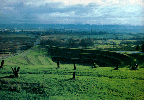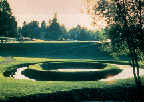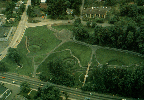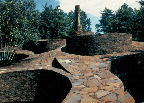Reclamation Art: Restoring and Commemorating Blighted Landscapes
|
Figure
1: Herbert Bayer, Mill Creek Canyon
Earthworks, 1979-82. 2.5 acres. Kent, WA. Photo by John Hoge
and Nancy Leahy, courtesy of the Kent Arts Commission. Used by
permission.
|
These images are from an ongoing research and aesthetic interest of mine: the examination of artworks that have been proposed or constructed by contemporary artists as a means to reclaim landscapes that have been damaged by human activities. My research interest stems from broader questions about the social and spatial impacts of the arts in this country. My aesthetic interest stems from a lifetime of interest in the arts and a fourteen-year career as an arts administrator before coming to the field of geography.
A number of artists have been providing aesthetic solutions to environmentally distressed and derelict landscapes such as strip mines, abandoned quarries, and waste dumps. These "reclamation art" projects are large-scale site-specific works that are designed to go beyond making the reclaimed sites safe and inoffensive and to add the creative statement of an artistic work. It seems natural for artists to become involved in assisting in the reclamation of distressed and abandoned landscapes. Some of the most frequent descriptors of strip mines and landfills are words such as "scar," "blight," "eyesore," "moonscape," implying an aesthetic response by the viewer. This reaction suggests that the visual damage which results from human activities in the landscape may be as important as the physical or social problems caused.
Since the 1960s many visual artists have focused on ecological issues in their work. Among these are Helen Mayer Harrison and Newton Harrison whose work, communicated through maps, photo-collages, and performance art, has drawn attention to human damage to watersheds. Another example is Mierle Laderman Ukeles, who has been working for over 25 years with such organizations as the New York City Department of Sanitation in the creation of art installations and public performances focusing on issues of urban waste. These artists and many others like them have used art to interpret environmental problems for the public.
A number of these artists have also provided site-specific aesthetic solutions to the problems of environmental damage. It is these large-scale reclamation projects that have drawn my attention. I am especially interested in the intentions of the artists in creating these works, as well as the impact of the artworks on both the physical and human geography of their sites.
The intended aesthetic impacts of reclamation art projects appear to be quite complex. For some artists and planners the goal has been to beautify the landscape, to transform eye-sores into appealing, contemplative spaces. To others, mine and landfill wastes are powerful symbols of our heritage that should not be minimized, but celebrated. They suggest that such sites may commemorate the important and necessary side effects of vital industries and livelihoods. Other artists have seen landfills and strip mines as powerful symbols of environmental degradation. For example, artist Robert Smithson was emphatically not interested in creating the picturesque in his reclaimed landscapes. He accepted human disruption of the landscape as inevitable and was prepared to assist with its renewal, but not to replace the sites with an image of idyllic nature. Artist Robert Morris made an even stronger statement on the concept of the aesthetics (and ethics) of art-as-reclamation:
- It would be a misguided assumption to suppose that artists hired to work in industrially blasted landscapes would necessarily and invariably choose to convert such sites into idyllic and reassuring places, thereby socially redeeming those who wasted the landscape in the first place....Will it be easier in the future to rip up the landscape for one last shovelful of a non-renewable energy source if an artist can be found (cheap, mind you) to transform the devastation into an inspiring and modern work of art? (quoted in Beardsley 1989 p.94).
List of Reclamation Art Projects
The following is a brief catalogue of the reclamation art projects I have seen or read about. I have included directions to the sites of several of the completed projects. I would appreciate hearing from anyone who has seen these projects. Since I have not visited all of these sites, please let me know if the directions or the descriptions are accurate. I would also appreciate hearing about other reclamation artworks that should be included in this listing. My e-mail address is FROST-KUMPF.HILARY@UIS.EDU
|
Figure
2: Robert Smithson, Rendering for
Bingham Copper Mining Pit--Utah Reclamation Project, 1973.
Wax Pencil, tape, plastic overlay and map, 20 1/2 x 30 1/2 in.
Original in the collection of Elmer Johnson. Photo by Gregory
W. Schmitz. Used by permission.
|
Artist Robert Smithson was an early pioneer in proposing that artists should have a role in reshaping disturbed landscapes:
- A bleached and fractured world surrounds the artist. To organize this mess of corrosion into patterns, grids and subdivisions is an aesthetic process that has scarcely been touched....Art can become a resource that mediates between the ecologist and the industrialist (quoted in Beardsley 1989 p.22).
|
Figure
3: Herbert Bayer, Mill Creek Canyon Earthworks, 1979-82.
2.5 acres. Kent, WA. Photo courtesy of the Kent Arts Commission.
Used by permission.
|
Herbert Bayer's Mill Creek Canyon Earthworks (Figure 3) was commissioned by the King County Arts Council and the Kent Parks Department as a solution to urban runoff problems in a storm water retention basin in suburban Seattle. Bayer's design includes a high berm to prevent erosion and a series of five geometric earth forms to control runoff into Mill Creek Canyon. The earthen forms include a round mound, an oblong mound, a cone supporting a bridge over the creek, a ring mound and pond (see Figure 1), and a ring mound bisected by the creek. During the dry seasons the forms provide a grassy park for community recreation. The project continues to be maintained and is a popular local park.
Directions: Mill Creek Canyon Park, Titus and Canyon Streets, Kent, WA.
|
Figure
4: Harvey Fite, Opus 40, 1939-76,
Unfinished. Bluestone, 6.5 acres. Saugerties, NY. Photo from Beardsley
1989. Unable to locate copyright owner, see Use
of Images.
|
Harvey Fite's Opus 40 (Figure 4) is a stonework sculptured environment of terraces, steps, ramps, cylinders, pedestals and pools in an abandoned bluestone quarry at an 11-acre site in the Catskills. Fite's original intention was to mine the deposit for material for his sculptures and then to use the space as an outdoor display and work area. But over the course of nearly forty years of removing stone, and molding the space, he turned the pit into an artwork itself. Fite's reclamation not only succeeded in removing a blight from the landscape, but it also demonstrated how a space can actually evolve through use into an aesthetic expression.
The site is managed by the Friends of Opus 40, 7480 Fite Road, Saugerties, NY 12477. The site is open to the general public Memorial Day through the end of October, Friday-Sunday, from 12-5 pm. An admission fee is charged. The site is closed some Saturdays when the grounds are reserved for weddings or concerts. For more information call (914) 246-3400.
Directions: Take the New York State Thruway to Exit 20-Saugerties. Take Route 212 toward Woodstock, watch for Opus 40 signs.
 |
|
Figure
5: Robert Morris, Untitled, 1979.
Johnson Gravel Pit #30, 3.7-acres, King County, WA. Photo by Colleen
Chartier/Art on File. Used by permission in reduced size only.
|
Robert Morris' Untitled (Figure 5) is an earth sculpture amphitheater which was commissioned by the King County Arts Commission for an abandoned gravel pit in Seattle. The completed work is a roughly oval-shaped terraced bowl that can be read as an amphitheater, but also as a mine pit. On the sides of the slope are creosoted tree stumps. Morris appeared to be using the ambiguous shape and the stumps as an emblem of both human progress and the physical despoliation of the land.
Ironically, the site was severely eroded as a result of soil destablized when the artist cleared away shrubs and trees to dramatize the industrially disturbed nature of the area. The site has also suffered from vandalism. The King County Arts Commission recently received a grant from the county for restoration of this work.
Directions: 10 miles south of Seattle, 1/2 mile east of I-5 at the intersection of 40th Place South and South 216th Street. Exit I-5 at South 200th St., turn east, follow Military Rd. to South 216th, and bear left.
|
Figure
6: Harriet Feigenbaum, Erosion and
Sedimentation Control Plan for Red Ash and Coal Silt Area--Willow
Rings, planted 1985, photographed 1995. 15 acres, silt pond,
near Scranton, PA. Photo by author. Used by permission.
|
Harriet Feigenbaum's Erosion and Sedimentation Control Plan for Red Ash and Coal Silt Area--Willow Rings (1985), is a planting design at a 15-acre silt pond site at the former Greenwood Colliery in Scranton, Pennsylvania, now an office park developed by Montage Mountain Industrial Development Corporation. Feigenbaum planted a double row of willow trees around the pond to control erosion and to aesthetically and ritually encircle the wounded site. The artwork was funded by the Greater Scranton Chamber of Commerce and the National Endowment for the Arts. The project is supposedly being maintained as a permanent wetlands for wildlife, however little attention seems to be given to maintaining the artwork. As seen in the photograph (Figure 6), a number of the willow trees have been allowed to die. In addition, the trees on the side closest to the road are being overwhelmed by rock-fall from a highway widening project. The developers of Montage Mountain appear to be ignoring and defacing the very project they commissioned to reclaim the land. Geographer John Krygier suggested that Willow Rings is a "derelict artwork in a derelict landscape."
Directions: Take Exit 51 off Route 81, east to Montage Mountain Rd., turn right, travel one quarter mile. The site is in a depression on the left side of the road.
|
Figure
7: Site of Harriet Feigenbaum's proposed
Dickson City Land Waves , photographed 1995. Storrs Pit
Strip Mine, 200+ acres. Dickson City, PA. Photo by author. Used
by permission.
|
Two earlier reclamation art projects by Feigenbaum, Valley of 8,000 Pines and Black Walnut Forest also appear to be a derelict. The works were part of her proposed Dickson City Land Waves at a massive strip mine site near Scranton (Figure 7). The three part project was to consist of large-scale plantings of trees and vineyards. In 1983 Feigenbaum planted a 20-acre parcel with thousands of seedling pines to restore fertility and control erosion. She used the trees as a sculptural element by planting them in a serpentine design to evoke a well known local image of a coal train snaking its way down the mountain, as well as to suggest the gently rolling slopes that surrounded the valley before industrialization. In 1984 Feigenbaum planted Black Walnut Forest with 2,000 seedlings in a spiral configuration of rows of trees radiating outward. The design was inspired by ritual circles and rings.
Unfortunately the entire project appears to have been obliterated. None of the pine and walnut trees can be seen on the site, and the vineyard project was never started. Supposedly, Feigenbaum's work was destroyed by dirt-bikers who invaded the site and left a new set of scars on the landscape. However, the derelict landscape of strip mining, artwork, and ATV trails that was Storrs Pit is now being redesigned by the bull dozers of development. Commercial strip malls, massive retail complexes, and housing subdivisions are taking over the site.
Directions: Behind Viewmont Mall, at northeast corner of Route 6 and Route 81 in Dickson City, PA.
|
Figure
8: Michael Heizer, Water Strider
of the Effigy Tumuli Sculptures, 1983-85. Photographed
in 1985 just after construction and seeding. Compacted earth,
685 x 80 x 14 ft. Buffalo Rock State Park, Ottawa, IL. Photo by
D. Gorton/Onyx from Beardsley 1989. Unable to locate copyright
holder, see Use of Images.
|
I include this project, the Effigy Tumuli Sculptures, as a reclamation artwork, even though the artist, Michael Heizer, denied the project was reclamation. To him, the project was "strictly art" and the site restoration was of no interest. But those who commissioned Heizer, including the Ottawa Silica Company and the State of Illinois Abandoned Mine Reclamation Council, certainly saw the introduction of an aesthetic dimension as part of the reclamation of the site. Their plan was to create a massive public sculpture park to rival Mount Rushmore. The work consists of five enormous earthen mounds on the site of a 154-acre former coal strip mine in northern Illinois. The mounds are geometrically abstracted shapes of a water strider (Figure 8), a frog, a catfish, a turtle and a snake all sculpted from the spoils piles. The images were meant to evoke both the natural fauna of the area, as well as to remind viewers of prehistoric Indian effigy mounds found throughout the upper Midwest.
As a reclamation project and public art piece, Effigy Tumuli has been highly problematic. Although the site was carefully contoured and treated for erosion and acidic soils, the site has not revegetated as intended. Most of the mounds show very patchy plant growth and massive gashes from soil runoff. The site has also not become the tourist attraction that was hoped, even though it is attached to a state park. The mounds have been obscured by the erosion and, in any case, were never easy to see except from the air. In addition, the construction of the project was apparently very contentious locally. For a fascinating critique of the work and more details about local responses to the site, see Doss 1995.
Directions: Buffalo Rock State Park is two miles west of Ottawa, IL. From Ottawa, drive west on Route 6, south on Boyce Memorial Dr., and west on Dee Bennett Rd. to the park.
|
Figure
9: Mel Chin,Revival Field II,
first planted 1992, photographed 1995. Palmerton, PA. Photo by
author. Used by permission.
|
Artist Mel Cin has created a series of reclamation art projects called Revival Fields. The projects are intended as demonstrations of how certain plants can be used to safely remove and recycle heavy metals from the soil. Chin works closely with agronomist Rufus L. Chaney of the United States Department of Agriculture to test the effects of hyperaccumulator plant species on land contaminated with heavy metals such as cadmium and zinc. Various hybrids of corn, bladder campion, and alpine pennythrift, are being used to determine if the plants can detoxify the site. The idea is that the biomass would be regularly harvested and processed to reclaim and recycle the metals.
Revival Field I was at Pig's Eye Landfill in St. Paul, Minnnesota, a "Superfund" site laced with cadmium. The field was planted for three growing seasons from 1990 to 1993. The artwork was a very formally laid out circle within a square, bisected by two crossed paths, signifying the earth as a target for regeneration. Revival Field II is a quarter circle planting in Palmerton, Pennsylvania (Figure 9). The entire community of Palmerton has been badly damaged by zinc fallout from nearly 80 years of zinc smelting in the area. The soils of the area have been made highly toxic and the mountains near the zinc plants have been totally stripped of vegetation. Revival Field II was planted in 1992 and will continue through the 1996 growing season. Chin also created two circular Revival Fields in The Netherlands. One is a control site at Zoetermeer, a planned community near The Hague, the other is on a contaminated smelting site near the Belgian border.
The scientific aspects of the Revival Fields appear to have been successful in terms of gathering data and raising awareness of the potential of hyperaccumulator plants. However, the art aspects of Revival Fields have been highly contested. An original grant from the National Endowment for the Arts for Revival Field I was awarded, rescinded, and then reinstated based on concerns that the project was not art. Similarly, the City Council of Palmerton expected that Chin's Revival Field II would create a pretty garden, not a complex science project. But for Chin, the projects are sculpture in unseen material (biochemistry and agriculture) whose aesthetic is revealed in a revitalized earth. In addition, Chin included more subtle symbology in the design of the fences and plot markers at each site. By including elements of Mayan mathematical notation, Chin is apparently appealing to the antiquity of the necessary relations of humans to the earth.
Directions to Revival Field II: Northeast corner of Hazard and Delaware Streets in Palmerton, PA. First traffic light east of Route 248.
|
Figure
10: Proposed site for Nancy Holt Sky Mound, 1986. 57
acres, height 100 ft. Meadowlands landfill in Hackensack, New
Jersey. Photo by the artist. Used by permission.
|
A landfill in northern New Jersey (Figure 10) is the site for Sky Mound, a proposed reclamation art project by artist Nancy Holt. Her design would transform the site into a public park and astral observatory, as well as a habitat for plants and migrating birds. The site is a 57-acre, 100-foot mound, filled with over 10 million tons of garbage. The landfill has already been sealed and a methane gas recovery system has been installed. Holt's proposal would carefully sculpt the mound into a series of smaller earth mounds with steel poles and gravel pathways which would be seasonally aligned to the sun and other stars (Figure 11). This contemporary Stonehenge would mark the equinoxes and solstices and other astral phenomena. For example, the archways of the methane wellheads would frame the moon in its extreme positions in relation to the earth. Unfortunately, this innovative transformation of a trash heap into a platform to observe the cosmos has been put on hold. Apparently the site is still settling and is not yet stable enough for Holt's constructions.
|
Figure
11: Nancy Holt Sky Mound Rendering:
Sun-viewing area with pond and star-viewing mounds, 1985.
Graphite on paper, 23 1/2 x 47 1/2 inches. Photo by the artist.
Used by permission.
|
Holt recently completed a reclamation art project in Europe (photos not yet available). The project, called Up and Under, is at an abandoned sand pit in Nokia, Finland. The work is an curved earth mound 620 feet long, about 12 feet high, and wide enough for a walking path on top. The mound snakes around three small pools and is intersected at several places with tunnels aligned to the compass points. It ends with a 26 foot conical mound which contains a vertical tunnel framing the sky. Directions to the site not yet available.
Other Reclamation Art Projects
- Agnes Dene's 1982 Wheatfield--A Confrontation, was planted for one season on a 2-acre landfill that had been created for a construction project in Battery Park in lower Manhattan.
- Denes was commissioned in 1990 by the city of Berkeley, California to work with landscape architects to create a design for North Waterfront Park on a 97-acre landfill. No details available on the progress of the project.
- Denes was commissioned in 1992 by the government of Finland to create Tree Mountain--A Living Time Capsule for the Ylojarvi Sandpits in Finland. The work is to be a spiral forest of 10,000 trees planted by 10,000 people from around the world and is to be left undisturbed for 400 years.
- Stan Dolega in 1981 created a sculpture of geometric terraces at a landfill/coal mine site in Hanna, Wyoming.
- Heather McGill and John Roloff created Isla de Umunnum (date unknown), as wetland reclamation in California.
- Aviva Rahmani's Medicine Wheel Garden (date unknown) on the Maine coast, was reported to be a reclamation project, but no other details are available.
- Reclamation Artists are a group of artists, landscape architects, and architects in Boston who have been creating a series of temporary installations at sites in the city which are threatened by redevelopment. Their varied projects since 1989 highlight the lost history and ecological conditions of the sites and include proposals for permanent site-specific reclamation projects.
- Alan Sonfist created a reclamation art project in Paris along a defunct highway system outside the city (circa 1980s). The artwork is an evocation of the historic marches and forests underlying such Paris monuments as Notre-Dame, the Lourve, and the Palais de Chaillot. Many of Sonfist's numerous projects in the United States and Europe could be described as "environmental" in that they are in the landscape and are designed to remind the viewer of past natural landscapes within the urban areas. Only the Paris project seems to fit the definition of "reclamation art" in that it is taking place in a derelict landscape, the abandoned roadway system.
- Mierle Laderman Ukeles has proposed a number of projects at landfills in New York City. Her project for Fresh Kills in Staten Island, the largest landfill on earth, is apparently proceeding.
- Ukeles was commissioned to create a work for Danehy Park, a former landfill in Cambridge, Massachusetts (date unknown).
Bibliography of Major Works on Reclamation Art
Beardsley, John, 1989. Earthworks and Beyond, Abbeville Press, New York.
Doss, Erika, 1995. Sculptures from Strip Mines. Spirit Poles and Flying Pigs: Public Art and Cultural Democracy in American Communities. Smithsonian Institution Press, Washington, DC.
Matilsky, Barbara, 1992. Fragile Ecologies: Contemporary Artists' Interpretations and Solutions, Rizzoli International Publications, New York.
Oakes, Baile, 1995. Sculpting with the Environment - A Natural Dialogue, Van Nostrand Reinhold, New York.
Note: All of the books
and articles I have seen on reclamation art have come from art publishers
or art/architecture journals. I would appreciate learning of articles
on the subject in other sources.
Diligent effort has been made to locate the copyright holders of all images to seek permission for use in this site. Where permission has been received, it is so indicated. In some cases, however, the copyright holders of record could not be located. If you have current information on the addresses of these copyright holders, please contact me at FROST-KUMPF.HILARY@UIS.EDU
Copyright









